Items
-
 Trajanic Triumphal Monument Object Description: Erected by Emperor Trajan in 109 AD in order to commemorate the victory against the Dacians and their Marcommani allies at the same location in 102 CE. The monument is situated on a plateau, 1.5 km north of the actual village, on the highest point in the area, making the monument visible from considerable distance. The original height was 37.26 m, with a foundation diameter of 42.58 m. The monument’s circular base was decorated with a frieze of 54 metopes representing relief images of the battles between Romans and Dacians. An inscription stating that the monument was dedicated by Trajan to the Roman god Mars Ultor graced two faces of the monument’s upper hexagonal portion: MARTI ULTOR[I] IM[P(erator)CAES]AR DIVI NERVA[E] F(ILIUS) N[E]RVA TRA]IANUS [AUG(USTUS) GERM(ANICUS)] DAC]I[CU]S PONT(IFEX) MAX(IMUS) TRIB(UNICIA) POTEST(ATE) XIII IMP(ERATOR) VI CO(N)S(UL) V P(ater) P(atriae) ?VICTO EXERC]ITU D[ACORUM] ?---- ET SARMATA]RUM --------------------------------]E ""To Mars, the avenger Caesar the emperor, son of divine Nerva, Nerva Trajan, Augustus, who defeated the Germans, the Dacians, great priest, for the 13th time tribune of the plebeians, proclaimed emperor for the 6th time, elected consul for the 5th time, father of our homeland, after defeating the Dacian and the Sarmatian armies."" Crowning the structure was a trophy itself, flanked by three colossal statues representing a Dacian prisoner and two women. The monument was reconstructed for the first time in 1977 and subsequently in 2010 and 2013. Erected by Emperor Trajan in 109 AD in order to commemorate the victory against the Dacians and their Marcommani allies at the same location in 102 CE. The monument is situated on a plateau, 1.5 km north of the actual village, on the highest point in the area, making the monument visible from considerable distance. The original height was 37.26 m, with a foundation diameter of 42.58 m. The monument’s circular base was decorated with a frieze of 54 metopes representing relief images of the battles between Romans and Dacians. An inscription stating that the monument was dedicated by Trajan to the Roman god Mars Ultor graced two faces of the monument’s upper hexagonal portion: MARTI ULTOR[I] IM[P(erator)CAES]AR DIVI NERVA[E] F(ILIUS) N[E]RVA TRA]IANUS [AUG(USTUS) GERM(ANICUS)] DAC]I[CU]S PONT(IFEX) MAX(IMUS) TRIB(UNICIA) POTEST(ATE) XIII IMP(ERATOR) VI CO(N)S(UL) V P(ater) P(atriae) ?VICTO EXERC]ITU D[ACORUM] ?---- ET SARMATA]RUM --------------------------------]E ""To Mars, the avenger Caesar the emperor, son of divine Nerva, Nerva Trajan, Augustus, who defeated the Germans, the Dacians, great priest, for the 13th time tribune of the plebeians, proclaimed emperor for the 6th time, elected consul for the 5th time, father of our homeland, after defeating the Dacian and the Sarmatian armies. Crowning the structure was a trophy itself, flanked by three colossal statues representing a Dacian prisoner and two women. The monument was reconstructed for the first time in 1977 and subsequently in 2010 and 2013.
Trajanic Triumphal Monument Object Description: Erected by Emperor Trajan in 109 AD in order to commemorate the victory against the Dacians and their Marcommani allies at the same location in 102 CE. The monument is situated on a plateau, 1.5 km north of the actual village, on the highest point in the area, making the monument visible from considerable distance. The original height was 37.26 m, with a foundation diameter of 42.58 m. The monument’s circular base was decorated with a frieze of 54 metopes representing relief images of the battles between Romans and Dacians. An inscription stating that the monument was dedicated by Trajan to the Roman god Mars Ultor graced two faces of the monument’s upper hexagonal portion: MARTI ULTOR[I] IM[P(erator)CAES]AR DIVI NERVA[E] F(ILIUS) N[E]RVA TRA]IANUS [AUG(USTUS) GERM(ANICUS)] DAC]I[CU]S PONT(IFEX) MAX(IMUS) TRIB(UNICIA) POTEST(ATE) XIII IMP(ERATOR) VI CO(N)S(UL) V P(ater) P(atriae) ?VICTO EXERC]ITU D[ACORUM] ?---- ET SARMATA]RUM --------------------------------]E ""To Mars, the avenger Caesar the emperor, son of divine Nerva, Nerva Trajan, Augustus, who defeated the Germans, the Dacians, great priest, for the 13th time tribune of the plebeians, proclaimed emperor for the 6th time, elected consul for the 5th time, father of our homeland, after defeating the Dacian and the Sarmatian armies."" Crowning the structure was a trophy itself, flanked by three colossal statues representing a Dacian prisoner and two women. The monument was reconstructed for the first time in 1977 and subsequently in 2010 and 2013. Erected by Emperor Trajan in 109 AD in order to commemorate the victory against the Dacians and their Marcommani allies at the same location in 102 CE. The monument is situated on a plateau, 1.5 km north of the actual village, on the highest point in the area, making the monument visible from considerable distance. The original height was 37.26 m, with a foundation diameter of 42.58 m. The monument’s circular base was decorated with a frieze of 54 metopes representing relief images of the battles between Romans and Dacians. An inscription stating that the monument was dedicated by Trajan to the Roman god Mars Ultor graced two faces of the monument’s upper hexagonal portion: MARTI ULTOR[I] IM[P(erator)CAES]AR DIVI NERVA[E] F(ILIUS) N[E]RVA TRA]IANUS [AUG(USTUS) GERM(ANICUS)] DAC]I[CU]S PONT(IFEX) MAX(IMUS) TRIB(UNICIA) POTEST(ATE) XIII IMP(ERATOR) VI CO(N)S(UL) V P(ater) P(atriae) ?VICTO EXERC]ITU D[ACORUM] ?---- ET SARMATA]RUM --------------------------------]E ""To Mars, the avenger Caesar the emperor, son of divine Nerva, Nerva Trajan, Augustus, who defeated the Germans, the Dacians, great priest, for the 13th time tribune of the plebeians, proclaimed emperor for the 6th time, elected consul for the 5th time, father of our homeland, after defeating the Dacian and the Sarmatian armies. Crowning the structure was a trophy itself, flanked by three colossal statues representing a Dacian prisoner and two women. The monument was reconstructed for the first time in 1977 and subsequently in 2010 and 2013. -
 Under Life-size Head of a Tetrarch
Under Life-size Head of a Tetrarch -
 Silver dish inscribed in the honor of emperor Licinius Production Marks: The stamp punctuating the first and last letters of the inscription around the periphery suggests the dish was manufactured in the city of Naissus.
Silver dish inscribed in the honor of emperor Licinius Production Marks: The stamp punctuating the first and last letters of the inscription around the periphery suggests the dish was manufactured in the city of Naissus. -
 Haloed Dionysus riding on leopard (removed to museum)
Haloed Dionysus riding on leopard (removed to museum) -
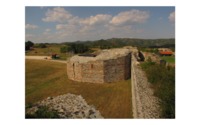 Towers and gate on the western side of the younger fortification; Felix Romuliana/Gamzigrad
Towers and gate on the western side of the younger fortification; Felix Romuliana/Gamzigrad -
 Passage at Justiniana Prima
Passage at Justiniana Prima -
 Eastern gate of the newer fortifications, Felix Romuliana/Gamzigrad
Eastern gate of the newer fortifications, Felix Romuliana/Gamzigrad -
 Tumulus of a Roman Officer Object Description: The tumulus marks the incineration tomb of a Roman Commander who perished in the battle of 102 CE. Circular in form, with a diameter of 46m, and height of 7m, the structure was made of stone, wood, and earth.
Tumulus of a Roman Officer Object Description: The tumulus marks the incineration tomb of a Roman Commander who perished in the battle of 102 CE. Circular in form, with a diameter of 46m, and height of 7m, the structure was made of stone, wood, and earth. -
 Pilaster decorated with a standard bearing imperial portraits Object Description: This rectanular pilaster preserves decoration on three sides (one wide face and the two narrow sides). The front face is divided into a narrow upper section decorated with a vegetal (stylized acanthus?) pattern. Below, the much larger middle section. This section is outined by a running vine (ivy?) marking all four side of a rectangular field. Centered within the vegetal frame is a representation of a military standard featuring five circular fieldspositioned along a vertical pole with a round finial at top and crescent-shaped bird-like representation at bottom. the pole terminates in what appears to be some sort of tapered end-cap. The top, central, and bottom roundels contin representations of a pair of male figures. In each case, the left-most figure is depicted as slightly taller than his companion. The figures contained in the middle and upper roundels are depicted as wearing a military cloak, while the figures in the lower roudel wear a toga. Placed between the upper and middle figural roundels, the circular element is likely a wreath, while the round element between the middle and lower figural roundels is a shallow dish-like shape.
Pilaster decorated with a standard bearing imperial portraits Object Description: This rectanular pilaster preserves decoration on three sides (one wide face and the two narrow sides). The front face is divided into a narrow upper section decorated with a vegetal (stylized acanthus?) pattern. Below, the much larger middle section. This section is outined by a running vine (ivy?) marking all four side of a rectangular field. Centered within the vegetal frame is a representation of a military standard featuring five circular fieldspositioned along a vertical pole with a round finial at top and crescent-shaped bird-like representation at bottom. the pole terminates in what appears to be some sort of tapered end-cap. The top, central, and bottom roundels contin representations of a pair of male figures. In each case, the left-most figure is depicted as slightly taller than his companion. The figures contained in the middle and upper roundels are depicted as wearing a military cloak, while the figures in the lower roudel wear a toga. Placed between the upper and middle figural roundels, the circular element is likely a wreath, while the round element between the middle and lower figural roundels is a shallow dish-like shape. -
 Venatores mosaic fragment 4 (removed to museum) Production Marks: N/A
Venatores mosaic fragment 4 (removed to museum) Production Marks: N/A -
 Venatores mosaic fragment 3 (removed to museum) Production Marks: N/A
Venatores mosaic fragment 3 (removed to museum) Production Marks: N/A -
 Venatores mosaic fragment 2 (removed to museum) Production Marks: N/A
Venatores mosaic fragment 2 (removed to museum) Production Marks: N/A -
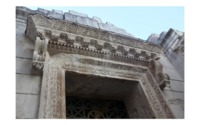 Lintel decoration from the So-Called Temple of Jupiter, Split
Lintel decoration from the So-Called Temple of Jupiter, Split -
 Venatores mosaic fragment 1 (removed to museum) Production Marks: N/A
Venatores mosaic fragment 1 (removed to museum) Production Marks: N/A -
 Mausoleum at Split (NW side)
Mausoleum at Split (NW side) -
 Mosaics from palace 1, room 1 (in situ) Production Marks: N/A
Mosaics from palace 1, room 1 (in situ) Production Marks: N/A -
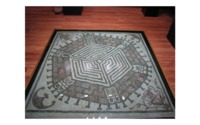 Labyrinth mosaic from palace 1, room 1 (removed to museum) Production Marks: N/A
Labyrinth mosaic from palace 1, room 1 (removed to museum) Production Marks: N/A -
 Porphyry Wing Fragment 2 Production Marks: N/A
Porphyry Wing Fragment 2 Production Marks: N/A -
 Porphyry Wing Fragment 1 Production Marks: N/A
Porphyry Wing Fragment 1 Production Marks: N/A -
 Basement (crypt) room of the mausoleum at Split
Basement (crypt) room of the mausoleum at Split -
 Gate at Split
Gate at Split -
 Coffered ceiling from the interior of the so-called temple of Jupiter, Split
Coffered ceiling from the interior of the so-called temple of Jupiter, Split -
 Miniature porphyry foot 1 Object Description: Under life-size right foot; DIMENSIONS??? Broken diagonally proceeding from ankle to top quadrant of upper in-step. Nails and cuticules sculpturally aticulated.
Miniature porphyry foot 1 Object Description: Under life-size right foot; DIMENSIONS??? Broken diagonally proceeding from ankle to top quadrant of upper in-step. Nails and cuticules sculpturally aticulated. -
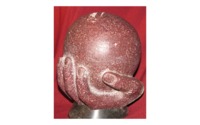 Porphyry Hand with Globe Production Marks: N/A
Porphyry Hand with Globe Production Marks: N/A -
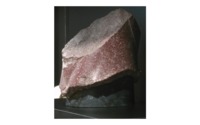 Porphyry Neck of a Tetrarch Production Marks: N/A
Porphyry Neck of a Tetrarch Production Marks: N/A